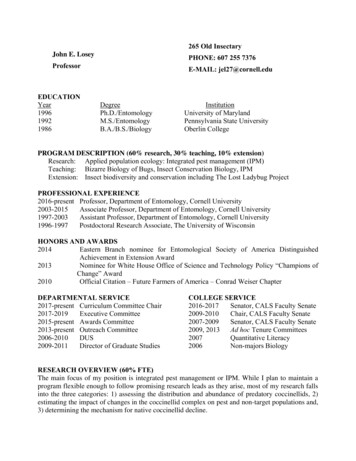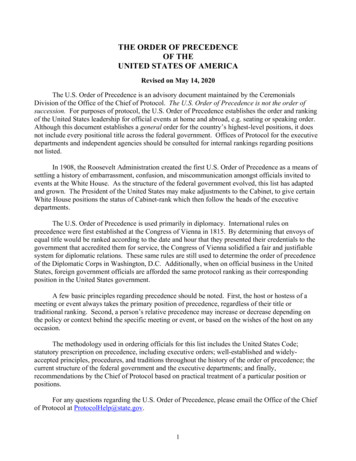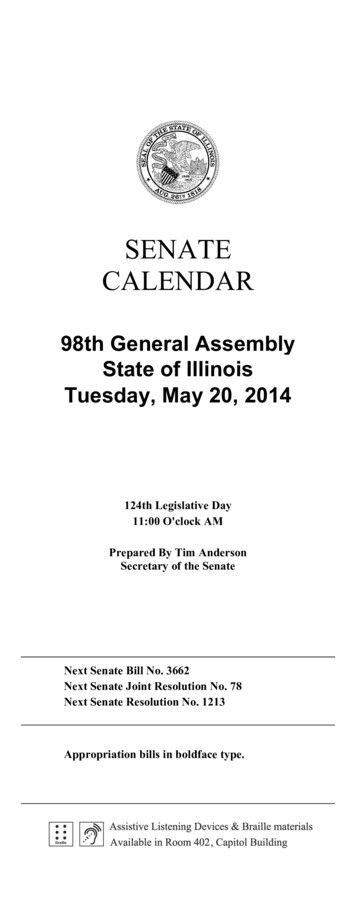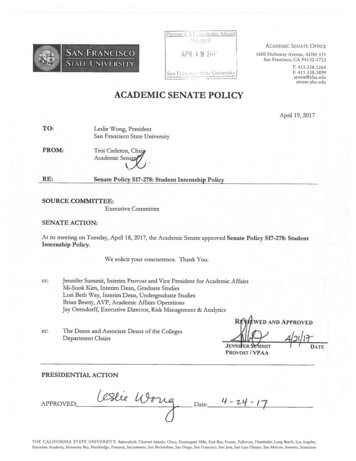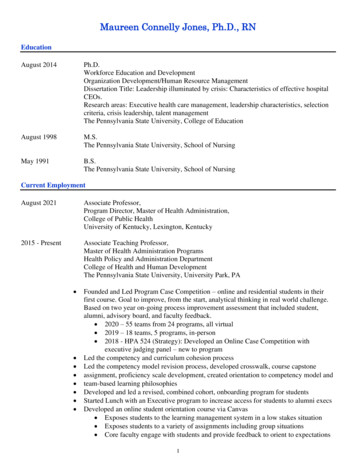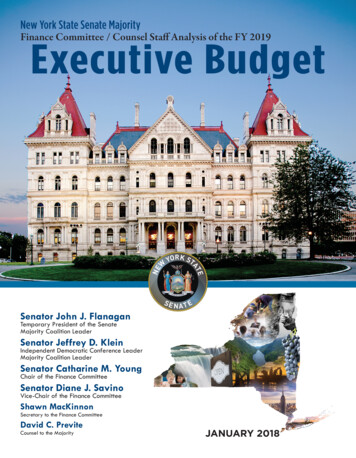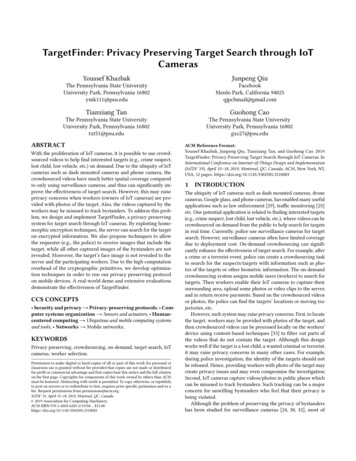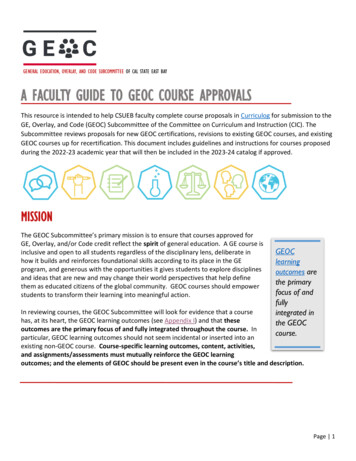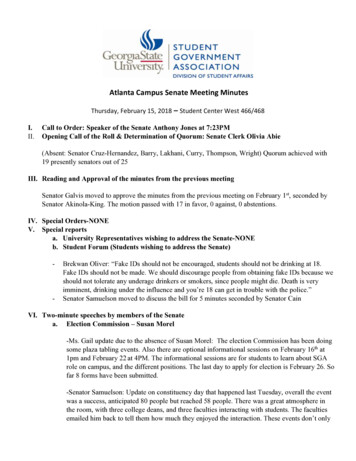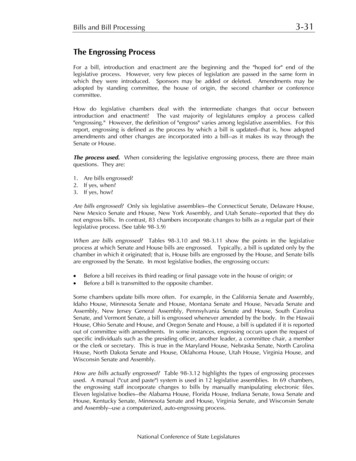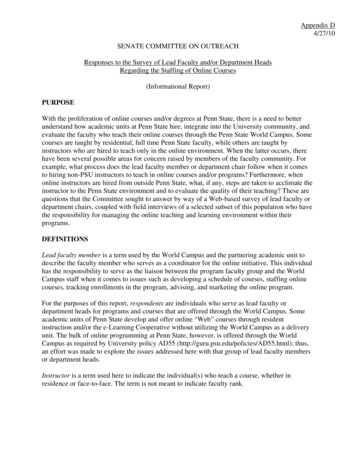
Transcription
Appendix D4/27/10SENATE COMMITTEE ON OUTREACHResponses to the Survey of Lead Faculty and/or Department HeadsRegarding the Staffing of Online Courses(Informational Report)PURPOSEWith the proliferation of online courses and/or degrees at Penn State, there is a need to betterunderstand how academic units at Penn State hire, integrate into the University community, andevaluate the faculty who teach their online courses through the Penn State World Campus. Somecourses are taught by residential, full time Penn State faculty, while others are taught byinstructors who are hired to teach only in the online environment. When the latter occurs, therehave been several possible areas for concern raised by members of the faculty community. Forexample, what process does the lead faculty member or department chair follow when it comesto hiring non-PSU instructors to teach in online courses and/or programs? Furthermore, whenonline instructors are hired from outside Penn State, what, if any, steps are taken to acclimate theinstructor to the Penn State environment and to evaluate the quality of their teaching? These arequestions that the Committee sought to answer by way of a Web-based survey of lead faculty ordepartment chairs, coupled with field interviews of a selected subset of this population who havethe responsibility for managing the online teaching and learning environment within theirprograms.DEFINITIONSLead faculty member is a term used by the World Campus and the partnering academic unit todescribe the faculty member who serves as a coordinator for the online initiative. This individualhas the responsibility to serve as the liaison between the program faculty group and the WorldCampus staff when it comes to issues such as developing a schedule of courses, staffing onlinecourses, tracking enrollments in the program, advising, and marketing the online program.For the purposes of this report, respondents are individuals who serve as lead faculty ordepartment heads for programs and courses that are offered through the World Campus. Someacademic units of Penn State develop and offer online “Web” courses through residentinstruction and/or the e-Learning Cooperative without utilizing the World Campus as a deliveryunit. The bulk of online programming at Penn State, however, is offered through the WorldCampus as required by University policy AD55 (http://guru.psu.edu/policies/AD55.html); thus,an effort was made to explore the issues addressed here with that group of lead faculty membersor department heads.Instructor is a term used here to indicate the individual(s) who teach a course, whether inresidence or face-to-face. The term is not meant to indicate faculty rank.
Appendix D4/27/10OVERVIEW OF THE STUDYAcross AY 2008/2009, the Committee developed a questionnaire that would be used to surveylead faculty or department heads in those units where online courses are offered through theWorld Campus (Part I). Part II of the study was designed to gather in-depth information viainterviews with individuals who have extensive experience with staffing and managing onlineprograms through the World Campus.The Principal Investigators for the study, Barbara Sims and Ann Taylor (Chair and Vice-Chair ofthe Committee, respectively), submitted a Human Subjects Review application through PennState’s Office of Research Protections that was approved in Spring 2009. The request forparticipation in Part I of the study was sent via e-mail to 76 lead faculty or department heads inJuly 2009. After two requests for participation, 32 individuals completed the online survey for aresponse rate of 42%. Field interviews associated with Part II of the study were completed acrossSummer and Fall 2009 and Spring 2010. A total of seven interviews were completed.FINDINGSQuantitative DataAs shown in Table 1, about 4 out of 10 survey respondents reported their position as departmentor unit head with 38% saying that they serve as the lead faculty member for online programmingwithin their unit. The six individuals who reported “other” to that question listed such responsesas “program administrative coordinator,” “associate head/lead faculty,” “school director,” or“program manager.”Table 1: Respondents’ Position Within Their UnitNumberPercentDepartment/unit head1241Lead faculty for online program1138Other621When asked to identify the academic college with which they are affiliated, 14 colleges wereidentified: College of Agricultural Sciences (3), College of Arts and Architecture (1), College ofEarth and Mineral Sciences (1), College of Education (3), College of Engineering (1), College ofHealth and Human Development (4), College of the Liberal Arts (6), The Eberly College ofScience (2), The Graduate School (1), Penn State Erie (1), Penn State Great Valley (1), PennState Harrisburg (4), Penn State Lehigh Valley (1), and the School of Nursing (1).-2-
Appendix D4/27/10When asked to report the number of online courses they are responsible for staffing, well over amajority reported 1-25 courses (83% of respondents); 7% reported staffing 26-50 courses and10% said that they are responsible for staffing between 51 and 75 online courses (See Figure 1).The next question in the survey asked respondents, “Who teaches online courses for yourdepartment/unit/program?” As shown in Table 2, almost two-thirds (63%) of respondents saidthey utilize a combination of the same faculty who teach their residential courses and additionalinstructors who are hired to teach online courses. Only two respondents said that they solely hireadditional instructors whose primary responsible is to teach online courses. The one “other”response indicated, “The same faculty plus some graduate students teach our online courses.”Table 2: Who Teaches Online Courses in Respondents’ Unit?NumberPercentThe same faculty who teach residential courses827Additional instructors are hired to teach online courses27A combination of both1963Other13A follow up question next asked those respondents who answered “a combination of both” to thequestion addressed in Table 2, “What percentage of the individuals who teach your onlinecourses also teach your residential courses?” This was an open ended question and the results arebest summarized as: four respondents stated about 10-25%; three respondents stated between 4050%; and 12 respondents reported that as being 60% or higher.-3-
Appendix D4/27/10The next set of questions was directed only to those respondents who said that they hireadditional instructors whose primary responsibility it is to teach online courses. The firstquestion in this section of the questionnaire asked about the hiring process for these onlineinstructors. Forty-four percent of respondents said that “the department head makes these hiringdecisions on his/her own.” One respondent stated that a search committee is formed comprisedsolely of members of the department’s residential faculty; two respondents said that a searchcommittee is formed comprised of both residential and online instructors; and seven respondentsgave a variety of responses to that question such as: Associate department head with consultation;Department head in consultation with the lead faculty member;Program Director; and,Lead faculty member conducts the search.When asked whether the process for hiring online instructors is the same as that used for hiringresidential faculty, and as shown in Figure 2, 66% of respondents said “no.”When asked to briefly explain how the process for hiring online instructors differs from that usedfor hiring residential faculty, the following comments were forthcoming:“Fixed term faculty members are hired as needed primarily from graduating graduatestudents who wish to stay in the area while waiting for a job or for a spouse to graduate.The department head decides who to hire and without a very formal process. Hiringonline instructors works in a similar fashion, except for the tenure track faculty whovolunteer to make the online course part of their teaching load. We provide this option toall faculty willing to do the training.”“For resident faculty on the tenure track, a formal search process is followed withadvertising. No advertising is done for online courses and no search committee isformed.”-4-
Appendix D4/27/10“Unlike the more formal search for residential faculty, the lead faculty member identifiesand hires online faculty in consultation with the department head.”“Because so few are needed, this is done informally.”When asked, “When hiring individuals to teach your online courses, do you considergeographically-distributed faculty for those positions (e.g. faculty who will not be expected torelocate to a Penn State campus),” about two-thirds (65%) of respondents said “yes.”As might be expected, online courses staffed by instructors with primary responsibility for thatvenue are filled by a mixture of FT I, FT II, and Supplementary I appointments (see Table 3).Table 3: Type of University Appointment Assigned to Instructors Hired to Teach Only OnlineNumberPercentFT – multi-year17FT I – yearly contract320FT II533Supplementary I320Other320The three “other” responses to this question included comments such as, “On load, FT I, FT II,and Supplemental I and II”; “World Campus calls them independent contractors.”; and, “BothFT1 and FT2.”Evaluating Online InstructorsTo better understand how online teaching effectiveness is evaluated, respondents were asked toconsider common strategies used to evaluate effective teaching (e.g. PSU’s SRTE system, peerreview of teaching, and the use of teaching portfolios). As shown in Table 4, 72% of respondentsreport using the SRTE to evaluate online instructors, while 28% said that they do not use theSRTE. Most stated, however, that they use the end-of-course evaluations that are used by theWorld Campus to evaluate students’ overall satisfaction with courses taught through thatplatform. Most respondents (72%) stated that they do not make use of teaching portfolios toevaluate online instructors.-5-
Appendix D4/27/10Table 4: Strategies Used to Evaluate Online InstructorsYesRegular review of SRTEsRegular review of World Campus end-of-courseevaluationsPeer review of online teachingPeriodic review of teaching portfoliosNo13 (72%)5 (28%)15 (83%)7 (39%)5 (39%)3 (17%)11 (61%)13 (72%)When asked about other techniques that they might use to evaluate online teaching, respondentsnamed such measures as: being included in online courses as a guest member in order to observeinstructor/student interactions; approving course content in advance by the lead faculty memberas means of quality control; and, paying attention to student complaints.Strategies Used to Integrate Online Instructors Into the UnitA set of questions were included in the study to measure the extent to which respondents makeuse of typical strategies often put into place to better integrate a new faculty member into thelarger faculty group and/or unit. The data in Table 5 suggest that lead faculty or departmentheads use a variety of the listed strategies. For example, all of them say that they provide samplesyllabi to online instructors; 89% that they introduce the new instructor to full time facultymembers; and, 72% say that they include the online instructor in communications sent out tofaculty. In addition, two-thirds of respondents report that they “help the individual to gainknowledge of the history, philosophy, and goals of the institution as a whole,” and that theyensure that the individual is included in PSU communications. Exactly half of the respondentssay that they include the individual in department meetings and involve him/her in curriculardecisions. Almost two-thirds (61%) say that they provide the new instructor with a jobdescription. Only a small number of respondents, however, report that they inform the onlineinstructor about possible service opportunities available to faculty at Penn State.-6-
Appendix D4/27/10Table 5: Strategies Used to Integrate Online Instructors into the UnitYesNoProvide a job description?11 (61%)6 (33%)Help the individual to gain knowledge of thehistory, philosophy, goals of the institution asa whole?12 (67%)6 (33%)Provide introductions to current faculty members?16 (89%)2 (11%)Provide example syllabi?18 (100%)0Include the individual in communications to faculty?13 (72%)4 (22%)Ensure that the individual is included in PSUcommunications from outside the department?12 (66%)6 (33%)Include the individual in department/unit meetings?9 (50%)9 (50%)Involve the individual in curricular decisions?9 (50%)9 (50%)Provide information about University serviceopportunities for faculty?3 (17%)15 (83%)An open-ended question allowed respondents to comment on other strategies that they use withnew online instructors. Those comments are summarized here: Hold weekly brown bag meetings with all non-tenure line instructors;Make use of Breeze [Adobe Connect] to hold discussions about the technology available tothem, etc.Distribute electronic newsletters to all FT II faculty with reminders and news items;Provide the University’s handbook for part-time instructors; and,Appoint some of these individuals to advisory councils.Of the five professional development opportunities shown in Table 6, three of them were usedmore so than others with online instructors: assistance with both developing and teachingeffective online courses and with providing technical assistance for technology-related problems.Fifty-five percent of respondents said that they hold new faculty orientations for onlineinstructors. Finally, most respondents said that professional travel funds are not made availablefor online instructors.-7-
Appendix D4/27/10Table 6: Professional Development Opportunities Provided Online InstructorsYesNoA new faculty orientation session?10 (56%)8 (44%)Instructional assistance related to designingeffective online courses?14 (78%)3 (17%)Instructional assistance related to teachingeffective online courses?15 (83%)2 (11%)Technical assistance with technology-relatedproblems in online courses?15 (83%)3 (17%)Travel funds for conferences and training?6 (33%)12 (67%)Additional Comments Contributed by RespondentsA final question of the online survey asked respondents to identify any challenges and/orconcerns that they have experienced when it comes to the offering of online courses throughtheir departments. The comments from respondents indicate the following areas of concern: High turnover with online instructors who leave for better professional opportunities;Balancing teaching loads so that teaching online does not have to be in an overload situation;Reluctance among some residential faculty members to teach online;Finding instructors who are qualified to effectively teach online courses;Predicting enrollments and staffing needs is always a challenge; and,Planning for growth and deciding whether to hire strictly online instructors or to capadmissions into the major.Qualitative DataAs previously noted, seven face-to-face interviews were completed as part of this study.Representatives were from the World Campus, three academic units with large World Campuscourses and/or programs, and three e-Learning support groups that are situated within academicunits. A summary of the findings from those interviews is presented here.World CampusA senior representative from the World Campus was interviewed for this study to learn moreabout the role that the World Campus plays in the hiring, integrating, and evaluation ofinstructors for online courses.-8-
Appendix D4/27/10Findings:Question 1 – “What is the process used for identifying faculty to teach [online] courses[delivered through the World Campus]?” Regardless of the gross revenue sharing model 1 , academic units/partners are responsible forsetting the curriculum and for selecting course authors and instructors. In the case of GRS-1 2 ,the World Campus provides the funds to hire the course author/instructor. Some academicpartners under GRS-1 are open to having the World Campus suggest instructors, while otherunits prefer to identify prospective instructors without assistance. Course instructors can be tenure-line faculty, full-time non-tenure faculty, fixed term,independent contractors, etc. Instructors do not need to be physically located at a Penn Statecampus location.Question 2 - “What professional development opportunities, if any, are made available by theWorld Campus to instructors? Are any of these required?” All new online faculty are invited to participate in the World Campus’ professionaldevelopment offerings, including OL2000, a 10-hour, online, introductory course for newinstructors that is offered over a three-week period beginning about five weeks prior to eachsemester. All instructors teaching via the World Campus are invited to other professionaldevelopment activities offered by World Campus online throughout the academic year.Question 3 – “What strategies, if any, does the World Campus use to involve online faculty inthe University community?” Since faculty teaching World Campus courses are hired by academic units, how those unitsintegrate their faculty into the department/University community varies.World Campus does,however, issue an online newsletter twice a semester and also forwards all officialannouncements that the University distributes, such as the 2009 announcements about H1N1.Question 4 – “What strategies, if any, does the World Campus use to evaluate online teachingeffectiveness?” Every course offered through the World Campus has an end-of-course evaluation. Theevaluation instrument and its distribution are modeled directly after the SRTE. The WorldCampus has participated now in the online SRTE pilot and will transition to the online SRTEin 2010-11. If an academic unit wants to also conduct a peer review of a course andinstructor, the World Campus can facilitate access to the course environment.1There are four Gross Revenue Sharing Models used to determine how course revenues are shared betweenacademic units and the World Campus.2With GRS‐1, the World Campus assumes all financial risk and guarantees recovery of College costs; the Collegereceives 10% of gross revenue.-9-
Appendix D4/27/10Academic Unit #1The first interview was with the head of an academic unit that offers 10 very large enrolling,online general education courses.Findings: Online course offerings enroll both residential and World Campus students.Each course has a lead instructor who is a traditional face-to-face faculty member. Additionalinstructors are hired, however, to handle the grading and daily course interactions. Theseindividuals work under the supervision of the lead instructor. As stated by the interviewee,“These individuals are typically folks who have a background and/or interest in the coursecontent, have taken the course previously, got an ‘A,’ and demonstrated a strong writingbackground.”Online instructors manage 75-120 students per section; “ .most teach 1-2 sections on top ofa day job and all are hired in fixed-term positions.”In addition to the individual section instructors, the department has a "Course Manager" whooversees all of their online courses: training new online instructors; conducting qualitychecks; and troubleshooting. This individual helps with course development and teaches thecourse the first time it is offered online (to debug).When it comes integrating these instructors into the larger faculty community, theinterviewee stated, “Department faculty don’t know about these instructors and really aren’tinterested. Since instructors are more like graders than traditional instructors, regulardepartmental faculty don’t see them as competition.”In terms of evaluating online teaching effectiveness, the unit reports that the lead instructorand course manager "watch like hawks" and analyze grades across sections.Professional development is provided primarily by the course manager, who gives instructorscoaching and initial training in course delivery and policies. Instructors are also told aboutadditional professional development opportunities at Penn State.Academic Unit #2The next interviewee is the chair of a program that offers its residential undergraduate programonline and entirely through the World Campus.Findings: This program has developed 11 courses for online delivery, including all of the core coursesfor the major and four upper level electives. For supporting courses, students in the major(now approaching a head count of 260) can enroll in upper level courses offered online byother disciplines.All courses were developed and are being taught by residential, full time instructors (sixtenure track and one FT I instructor).-10-
Appendix D4/27/10 Most courses are capped at 35 with the exception being the two writing intensive courses,one of which is the senior seminar. Those two courses are capped at 25.All faculty members had extensive assistance from World Campus staff, includinginstructional designers and technical support from the Outreach HelpDesk.The program as a whole benefits greatly from the marketing efforts through the WorldCampus and assistance with advising by World Campus staff, whom they view as highlytrained and professional.Since the same faculty who teach residential courses teach online courses, the questionsabout how faculty are hired, integrated into the faculty group, and evaluated does not applyto this particular program.Academic Unit #3The next academic unit to be interviewed offers an online graduate certificate program throughthe World Campus (specifically designed for non-residential adult learners; all courses at the500-level) and recently added an online masters degree that includes the courses developed forthe certificate program.Findings: Courses have a 25 student cap, but multiple sections of required courses are offered eachsemester. Enrollment in the certificate program has been growing between 25-50% per year.Students are typically adult learners who are working for a small company that doesn’tprovide a lot of in-house support/training, so they are seeking these online courses/programsto meeting their training needs.Typically the same individual who teaches the residential version of a given course serves asthe lead faculty member for the development of the online version and also teaches the onlinecourse the first time it is offered.Instruction of the online courses is coordinated with residential offerings. Whenever possible,the individual who is teaching the course in residence also teaches the online course thatsame semester. That provides an incentive to keep course requirements, pacing, and qualityin sync.As the number of online course sections needed grows, it is becoming harder to utilize thesame faculty to teach both in residence and online offerings. Therefore, the department isbuilding a team of instructors by seeking individuals who have taken the courses while a PhDstudent in the residential program. This ensures that all instructors have a sense of the PennState brand, know the department, and have already had graduate-level teaching experienceas teaching assistants.Instructors are given a “master” copy of an online course to teach, but have the flexibility torevise the materials to suit their needs and/or teaching style. Personalizing a course isimportant to both the instructor and to the students. Students occasionally request even moreof a personal instructional presence in a course, such as video, live chat, etc. Customizingcourses does present a challenge – the department wants to keep the sections from growingtoo far apart, while at the same time sharing best practices among instructors/sections.-11-
Appendix D4/27/10 New instructors are advised to take the World Campus’ OL 2000—a web-based, 3-weekintroduction to teaching online. The department has also conducted a couple of technologymediated training sessions to introduce instructors to new teaching technologies andstrategies. In addition, the instructional designer for the courses continues to send instructorsnew ideas, best practices, etc. via e-mail. The formal sessions worked well in terms ofbuilding a sense of community, so the department is considering having similar sessions oncea month with an agenda that focuses on sharing “what’s working and what isn’t?”Program courses currently utilize the World Campus’ End of Course survey. The evaluation,and its distribution, is modeled directly after the SRTE. Peer review of online courses has notbeen standard, but the department hopes to formalize that process, too.Faculty burnout is a concern. The department feels strongly that faculty should not take onmore than 20% overtime. That applies even if a course instructor holds a full-time jobelsewhere. For individuals who already hold a full-time job, that typically means teaching nomore than one course section online. The department does not want any faculty who teachsolely online. They believe that course instructors who are already Penn State employeesshould teach in residence, as well.As the department’s online masters degree gains momentum, academic advising will be aconcern. The certificate program has had a single academic advising point person. Thatmodel will not likely scale for the online masters degree.e-Learning Support Group #1Three interviewees are the directors of College-level “e-Learning Support Groups.” The first issituated within a large college that has a substantial number of online courses as part of theWorld Campus General Undergraduate Portfolio (GUP).Findings: The College’s online faculty are identified by individual academic departments. Departmentsprefer to integrate online teaching responsibilities into a FT I faculty member’s teaching load.Other practices include limited supplemental compensation for FT I faculty, use of FT IIfaculty, and limited hiring of graduate students (mostly in the summer).The College prefers to hire instructors whom they know. About 50% of the College’s onlineteaching faculty also teach face-to-face courses for the College. Instructors, especiallygraduate students, are generally eager to teach online courses as a way to gain experience indistance education.The profile of instructors for the College’s online courses closely mirrors the profile ofinstructors for their face-to-face courses. Gen Ed courses are often taught by TAs in bothrealms, while upper level courses are taught by more senior faculty, whether online or faceto-face.Minimum qualifications for teaching lower division courses online almost always include amasters degree. Online teaching experience is also sought. “New” candidates should beprepared to share teaching evaluations and letters of reference that speak to the individual’sability to teach.-12-
Appendix D4/27/10 New hires are expected to take the World Campus OL2000 course and it is expected thateach department will take the responsibility for mentoring and monitoring online faculty.Some departments offer their own online teaching training program.The departments rely on the World Campus end-of-course evaluations but will be moving tothe use of the online SRTEs in the near future. The College would also like to develop a peerreview process for their online courses.e-Learning Support Group #2The second e-Learning Support Group to be interviewed is situated in a well-established institutein a research-oriented college.Findings: One in four undergraduate credit hours generated by the College are associated with a “web”class. One in five college graduate students are enrolled in a World Campus program.The Institute is responsible for facilitating the growth of online programs for the College.Part of that role is to offer assistance to departments in designing, planning, building andsustaining online programs. The institute is increasingly entrusted by academic departmentsto explore potential candidates on the departments’ behalf. Ultimately, of course, eachdepartment makes final hiring decisions and is responsible for evaluations of performanceand quality assurance.There are two primary reasons why new instructors for online course offerings may be hired:1) The College has no excess instructional capacity, and 2) the instructional skill set anddisposition needed is different than what is needed for residential instruction.Relatively few of all instructors who teach online for the College also teach in residence.The College has a huge base of accomplished and loyal alumni who are reportedly thrilled atthe prospect of teaching part time for Penn State. Some work full-time elsewhere, some areretired, and some work elsewhere at Penn State (e.g., as a research associate) but teach onlinepart-time for the College.The general College community is reportedly not aware of the community of instructors whoteach their online students. There has been a lot of misunderstanding, suspicion, and mistrustfrom traditional faculty. Some departments in the College do make an effort to include onlinefaculty in departmental functions through media like Adobe Connect or MediaSite Live andby including online faculty in departmental web site faculty listings. The institute feels thatthe effort needs to come from both directions, however. To be recognized and respected bytheir resident peers, online faculty need to make the effort to attend faculty meetings anddepartmental functions, too.The College finds it hard to learn about professional development opportunities that areavailable related to teaching at a distance, some of the resources that might seem applicable,such as the handbook for part-time faculty are often disappointing, as they do not address the-13-
Appendix D4/27/10 unique needs of geographically dispersed faculty who teach online. The institute feels thatthere needs to be better recognition by the University that we are growing our faculty andthat the faculty is becoming more diversified. Professional developme
has the responsibility to serve as the liaison between the program faculty group and the World . Penn State Erie (1), Penn State Great Valley (1), Penn State Harrisburg (4), Penn State Lehigh Valley (1), and the School of Nursing (1). -2- Appendix D

